
Research Article
Austin J Environ Toxico. 2024; 10(1): 1046.
Investigation of Cu and Zn into Farmlands Irrigated with Livestock Wastewaters Using Nemerow Pollution Index
Shui-Wen Chang Chien¹; You-Cheng Chen¹; Cheng-Chung Liu²*
¹Department of Environmental Engineering and Management, Chaoyang University of Technology, Taichung, Taiwan
²Department of Environmental Engineering, National Ilan University, Ilan, Taiwan
*Corresponding author: Cheng-Chung Liu Department of Environmental Engineering, National Ilan University, Ilan, Taiwan. Tel: (0118863) 935-7400 (O); Fax: (0118863) 936-7642 Email: ccliu@niu.edu.tw
Received: November 29, 2023 Accepted: January 03, 2024 Published: January 10, 2024
Abstract
Animal husbandry flourishes in Yunlin County, Taiwan. Livestock wastewater has been commonly used as a fertilizer for decades. Such wastewater usually contains large amounts of Cu and Zn; however, over-irrigation deteriorates farmland and pollutes groundwater. Lunbei (ranches), Shuilin (pig farms), and Huwei (pig farms) townships were selected in the county for this study. To determine the accumulation of Cu and Zn in soils after irrigation, the single-factor pollution index (PI) and Nemerow pollution index (PN) were used to evaluate the pollution level and metal hazard at several monitoring sites within the irrigation group over four years. Furthermore, the data were used to identify sites with a high pollution potential. Speciation investigations of Cu and Zn were conducted to analyze their potential environmental threats. All PI levels were below 1.0, indicating that all the monitoring points were non-polluting. Although the calculated PN levels increased annually, the PN levels obtained in the third year were all lower than the safety threshold of 0.7. After irrigation, most of the available Cu and Zn in the soil were bound to organic matter and Fe-Mn oxyhydroxide, possibly posing environmental risks. Cu had a higher threat potential than Zn. The potential threat caused by irrigation with cow manure urine was more than that caused by irrigation with pig manure urine.
Keywords: Copper; Livestock wastewater; Nemerow index; Zinc
Capsule
The Nemerow pollution index is useful for monitoring the accumulation of toxic metals in soil.
Introduction
Animal husbandry is an important agricultural activity in Taiwan, accounting for 32% of the entire agricultural production as reported in the Annual Report of the Council of Agriculture, Executive Yuan (Taiwan). However, considerable amounts of wastewater are produced daily in animal husbandry. In earlier years, they were discharged into rivers or ditches without treatment, causing severe environmental pollution [1]. Livestock wastewater is rich in nutrients and organic matter, including nitrogen, phosphorus, and potassium. In addition, wastewater utilized as a fertilizer increases soil fertility and therefore lowers the use of chemical fertilizers, as well as achieves waste resource recovery.
In recent years, authorities in Taiwan’s agricultural affairs have implemented a livestock wastewater reuse policy. In 2009, the Council of Agriculture cooperated with researchers to conduct a test program for livestock wastewater reuse to encourage resource recovery from livestock wastewater [2]. Livestock and cropland farmers were invited to participate in forums and observation tours to understand the policy. The Environmental Protection Administration has also subsidized local governments to buy vehicles, irrigation tools, and storage tanks to encourage farmers to irrigate their croplands with livestock wastewater. However, Cu and Zn are commonly added to livestock feed as growth regulators to reduce growth time and prevent diseases [3]. Only 10–20% of Cu or Zn can be absorbed into the livestock body, but the residual Cu and Zn are excreted through manure and finally transferred to the livestock wastewater [4,5]. When considerable amounts of Cu and Zn are continuously brought into farmland through irrigation, accumulation occurs, encouraging their over-uptake. Eventually, metals are transferred to the human body through the food chain, posing health risks [6,7]. Heavy metals are considered persistent environmental pollutants. Organisms are difficult to degrade and thus have longer biological half-lives. A test result of Broadbalk agriculture from Rothamsted Research showed that the Cu and Zn concentrations in soil increased by approximately 60% after composting over 160 years [8]. Therefore, the long-term monitoring of irrigated croplands is necessary.
The Nemerow pollution index (PN), which helps determine heavy metals posing the greatest risk to a single environment, has been used to assess the effect of heavy metals on contaminated rivers or the effect of groundwater on plant growth in paddy soils [9]. An area with a high PN level indicates the area is severely polluted and requires increased attention [10,11]. Risk assessment of cropland to heavy metals allows us to determine the degree of pollution, which is classified as a high-, middle-, or low-risk indicator. This is also used to evaluate the extent to which cropland is used for agriculture if Cu and Zn consistently accumulate in the soil [12]. The single-factor (PI) and the Nemerow (PN) pollution indices are typical environmental indicators [13]. PI calculates the pollution level of each metal in the soil, and PN the comprehensive pollution impact of heavy metals [14]. They have been used to evaluate the potential of heavy metals in farms in Taiwan [15], to calculate the distribution of metalliferous sediments on the surface of the Yellow River in China [16], and to estimate the pollution of soil near steel mills in Iran [17].
This study aimed to use the Nemerow pollution index to (1) examine the accumulation of Cu and Zn in croplands after irrigation using livestock wastewater, (2) obtain evaluation data by calculating the Cu and Zn concentrations through indicators, (3) grade the soil using the monitoring point, and (4) identify the form of Cu and Zn in the irrigated croplands. These data were summarized, and the potential environmental threats through long-term irrigation were evaluated.
Methodology
Survey and Sampling Areas
Yunlin County is among the top three animal producers in Taiwan. Based on a report from the Council of Agriculture in 2020, the Yunlin area produces 28.4% of pigs in Taiwan. Therefore, Yunlin was selected as the survey area in this study. Three townships in this county, namely, Lunbei (ranches), Shuilin (pig farms), and Huwei (pig farms) were identified as major sampling areas (Figure 1). The document defines “irrigation” as using livestock wastewater as fertilizer in specific croplands. Irrigation in the Shuilin and Huwei areas involved pouring wastewater from a tank car and flooding the cropland, whereas in the Lunbei area, a tank car was coupled with furrow irrigation. Sampling was conducted during the dry season (March and May) and the rainy season (July and September) because the elemental contents of soil are easily affected by moisture. Table 1 shows the farm type, type of irrigation wastewater, number of monitoring points, and monitoring period for the experimental areas. The term “spare monitoring point” was defined as an irrigated monitoring point without livestock wastewater. Solid–liquid-separated raw water containing solid manure was used to irrigate the Lunbei area. Anaerobic swine wastewater that underwent a two-stage treatment without solid manure was applied to the Shuilin area. Aerobic swine wastewater that underwent a three-stage treatment and contained solid manure was used to irrigate the Huwei area.
Area
Farm type
Type of irrigation waste water
Number of monitoring points
Monitoring period
Spare monitoring point
Monitoring period
Lunbei
cattle farms
solid-liquid separated raw water
8
2018–2019
none
none
Shuilin
pig farms
anaerobic swine wastewater
2
2016–2019
1
2017–2019
Huwei
pig farms
aerobic swine wastewater
3
2016–2019
1
2017–2019
Table 1: Survey areas and monitoring period.
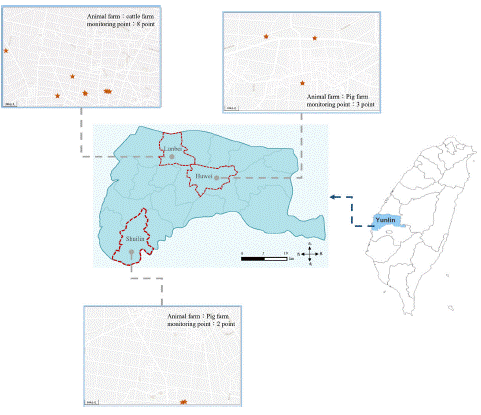
Figure 1: Soil sampling areas of this study.
Soil Sampling and Analysis
Irrigation wells are commonly established in croplands in Yulin County, Taiwan. Considerable groundwater is extracted from irrigation wells for paddy rice growth during the dry season. Three sampling sites were established in the croplands at each monitoring point. They were individually aligned 3, 6, and 9 m from the irrigation inlet. An auger was used to collect an adequate amount of topsoil (0–15 cm) and subsoil (15–30 cm) from each site. However, avoiding collecting soil mixed with fertilizer and manure during sampling is necessary. Triplicate sampling was performed for each site but the soil samples were mixed thoroughly. After air-drying, the soil samples were broken, ground, and passed through 2- and 10-mm sieves. The pre-treated samples were stored in plastic cans at room temperature. Livestock wastewater and groundwater extracted from the irrigation wells were also collected for analysis. After collection, the water sampling bottles were sealed and preserved in cooling equipment.
The soil pH was measured at a 1:1 soil-water ratio (w/v) using a pH meter (Sartorius PB-10, Germany). Electrical Conductivity (EC) was measured at a 1:5 soil-water ratio (w/v) using an electrical conductivity meter (SUNTEX SC 2300, Taiwan). The Cu and Zn concentrations were analyzed using inductively coupled plasma with an atomic emission spectrometer (iCAP 6300, USA) after digestion in an aqua regia solution (1:3 conc. HNO3:conc. HCl (v/v)). The Total Organic Carbon (TOC) content was determined using the combustion-infrared absorption method [18]. Total nitrogen was determined using the Kjeldahl method. The carbon-nitrogen ratio was calculated from the results of the total organic carbon and total nitrogen analyses. The pH and EC of the water samples were measured using a pH meter and electrical conductivity meter, respectively. The Cu and Zn concentrations in the water samples were determined using microwave-assisted acid degradation treatment. The ammonia nitrogen (NH3-N) contents of the water samples were determined using the phenate method [19]. The sequential extraction study used the method proposed by Tessier et al. [20], which was used to ascertain the speciation of Cu and Zn in different soil fractions after long-term irrigation with livestock wastewater. All chemicals used in this study were reagent grade and all experiments were conducted in triplicate.
Nemerow Pollution Iindex
The Nemerow pollution index (PN) has been used to evaluate the combined effects of heavy metals in soil [8,21,22]. The PN calculates the average of the evaluated heavy metals and weighs the most polluted metal items; it also dominates the variation in every polluted item. The single-factor pollution index (PI), which calculates pollutant standards for every heavy metal, provides a simple and fast evaluation of single pollutants in the soil to recognize individual items that cause the highest pollution in soil [13,22]. PI and PN were calculated using the following
PI: single factor pollution index
Ci: measured concentration of pollutant i
Csi: the value of evaluation standards of pollutant i
PN: Nemerow pollution index
n: pollutant items on the evaluation
PIi: pollution index of the pollutant i
PImax: pollutant items that have the highest pollution index
This study used the Nemerow pollution index to evaluate the annual effects of Cu and Zn on croplands irrigated with livestock wastewater. The irrigation curb standard was defined as 85% of soil pollution monitoring standards. Thus, 102 ppm (Cu) and 221 ppm (Zn) were used as evaluation standard values for the calculation. The annual PI, PN, and mean concentrations of Cu and Zn were calculated according to the process shown in Figure 2.

Figure 2: Process of calculation for PI and PN.
The evaluation standards for the pollution index (PI) and the Nemerow pollution index (PN) are presented in Table 2. The PI is graded to five levels from no pollution PI=1.0 to high pollution PI>5.0, whereas the PN is also graded to five levels from the safe level (PN0.7) to serious contamination (PN>3.0).
Evaluation level
Single factor PI
Evaluation level
Nemerow PN
No pollution
PI
.0
Safe level
PN
0.7
Slight pollution
1.0
2.0
Alert level
0.7
PN
1.0
Mild pollution
2.0
3.0
Mild pollution
1.0
PN
2.0
Medium pollution
3.0
5.0
Medium pollution
2.0
PN
3.0
High pollution
5.0
PI
Heavy pollution
3.0
PN
Data sources: (Fei et al., 2019) and; Wang et al., 2019)
Table 2: Evaluation standard for single factor pollution index and Nemerow pollution index.
Results and Discussion
Fundamental Properties of Livestock Wastewater and Solid Manure
Table 3 shows the basic properties and characteristics of used livestock wastewater. Variations were significant in the pH levels of all wastewaters (3.1–6.7%). The average pH level of wastewater irrigated in Huwei was significantly higher than others. This was attributed to the aerobic wastewater treatment process. Alkali liquor is commonly added to similar wastewater because the nitrification consumes alkali during the treatment, leading to water maintenance at pH 8.0 to 8.6 [25]. Annual EC averages from every stock farm ranged from 2,687 to 5,637 μS cm-1. Moreover, the annual Cu averages ranged from 0.11 to 2.80 mg L-1, and the annual Zn averages ranged from 0.59 to 13.5 mg L-1, indicating that properties among the swine wastewater varied significantly. Pig consumes more protein, adipose, and carbohydrate than cattle. When the pig excretes these substances, they gradually decompose to macromolecules by microorganisms or hydrolyze to dissolve salt ions. This leads to EC increasing in the manure. Cu and Zn are commonly added into the feed to make the pigs grow faster during their growth period, which also causes the swine wastewaters to have a high variability related to their contents. In Japan, Zn dosage in feed is recommended between 60 and 100 mg kg-1 when the piglets weigh 1 to 35 kg. Adequate Cu and Zn intakes are required for dairy cattle to maintain their health and high milk yield. The Cu and Zn demand for dairy cattle are 10 and 40 mg kg-1, respectively, in the feed. Evidently, the Cu and Zn contents in untreated pig solid manure were approximately six times higher than those of cattle (Table 4) [26,27]. As shown in Table 3, annual averages of NH3-N and TOC in the livestock wastewaters also appear to have notable differences, with their coefficients of variation ranging from 49% to 97%. This was attributed to different management and treatments among the stock farms. The nitrogen removal process in the oxic tank caused a large change in NH3-N content in Huwei soil. The annual TOC average in Lunbe soil, 736 mg L-1, was much higher than that of the others, with the coefficients of variation ranging from 11% to 56%. It was speculated that the cattle consumed staple food, Pennisetum, to obtain plenty of organic carbon, resulting in higher TOC content in raw water than in the swine water.
Area
Stock farm
Applied livestock wastewater
——– Monitoring item of livestock wastewater ——
pH
EC
Cu
Zn
NH3-N
TOCb
μS cm-1
————mg L-1————
Lunbei
Cattle farms
Solid-liquid separated raw water
Annual
averagea7.3±0.2
(3.1%)2687±463
(17%)0.30±0.17
(57%)1.32±0.63
(48%)117±57
(49%)736±254
(35%)Shuilin
Pig farms
Anaerobic swine wastewater
7.1±0.5
(6.7%)4519±1468
(32%)2.80±4.51
(162%)13.5±14.6
(109%)393±186
(48%)73.4±8.03
(11%)Huwei
Pig farms
Aerobic swine wastewater
8.2±0.4
(4.4%)5637±2940
(52%)0.11±0.13
(126%)0.59±1.24
(209%)422±411
(97%)68.8±38.8
(56%)(%) presents coefficient of variation, obtained from that standard deviation divided by mean value and multiplied by one hundred.
a: annual average was the mean of monitoring levels in each area, Lunbei 2018–2019 (n=8). Shuilin and Huwei 2016–2019 (n=16)
b: Total organic carbon; only three samples were tested from May, 2019 to September, 2019 (n=3).
Table 3: The properties of livestock wastewaters from different areas.
Area
Stock farm
Testing items of the manure
EC
Cu
Zn
μS cm-1
——mg kg-1——
Lunbei
Cattle farms
1196
16.0
161
Huwei
Pig farms
4970
92.3
918
Table 4: The properties of solid manure from different areas.
Cu and Zn in Soils
The average Cu and Zn concentrations in the soils of the three farms are presented in Table 5. The irrigated soils’ average Cu concentrations ranged from 20.5 to 25.4 mg kg-1, and the average Zn concentration ranged from 138 to 148 mg kg-1. In contrast, for the soil without irrigation (control group), average Cu concentrations ranged from 7.90 to 22.5 mg kg-1, and average Zn concentrations ranged from 70.5 to 95.2 mg kg-1. The results indicated that the Cu and Zn concentrations in the irrigated soils were always far lower than the irrigation curb standard. The soils in the Huwei area had higher original Cu content than those in the other areas. Moreover, the Cu content had higher variability than the Zn content because soil particles cannot quickly adsorb or release Zn2+ ions [28]. Zn2+ ions have a full electron configuration, [Ar] 3d104s0; thus, they have a weaker electrical attraction to negatively charged sites on soil minerals and organic matter [29]. As a result, the Zn content exhibited lower variability than the Cu content.
Area
Monitoring item of the soil
Cu
Zn
————mg kg-1—————
Lunbei
20.5±4.27 (21%)
138±18.3 (13%)
Shuilin
25.0±5.06 (20%)
148±22.7 (15%)
Control group of Shuilin
7.90±1.91 (24%)
70.5±8.20 (12%)
Huwei
25.4±4.14 (16%)
142±16.4 (12%)
Control group of Huwei
22.5±3.37 (15%)
95.2±11.2 (12%)
(%) presents coefficient of variation, obtained from that standard deviation divided by mean value and multiplied by one hundred
Annual average is the mean of monitoring levels in each area: Lunbei 2018–2019 (n=8), Shuilin and Huwei 2016–2019 (n=16), and the control group 2017–2019 (n=12).
Table 5: Cu and Zn concentrations in investigated croplands.
Nemerow Pollution Index and Analysis of Metal Form
Figures 3 and 4 show the PIs evaluated for Cu and Zn in the monitored soils. All the PI values of Zn were higher than those of Cu, indicating that Zn had a higher potential hazard. This may be attributed to the Zn content, which was approximately five times the Cu content in the livestock wastewater and ten times the Cu content in the manure. Moreover, Zn showed a higher background concentration (120 ppm) in the soil than Cu (50 ppm) in Taiwan. This has led to Zn in the monitored soil posing a higher potential environmental threat. The PI values of Cu and Zn at each monitoring point were within the non-pollution level range (PI=1.0) in 2019. Nevertheless, the PI values of Zn (0.8 and 0.96) at monitoring sites 7 and 8 were very close to a slight pollution level (PI>1.0) in 2018, and the PI value of Cu in monitoring point 8 was higher than any other ones. Therefore, although the PI level of Cu decreased in 2019, the soil at monitoring point 8 requires increased attention to be irrigated.
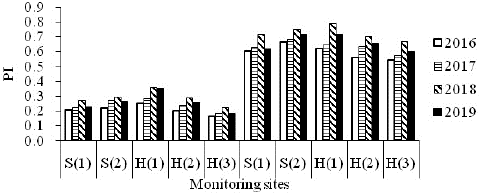
Figure 3: Pollution Index (PI) of monitored croplands in Shueilin and Huwei areas over the years. PI=1.0: non-pollution level, PI>1.0: slight pollution level, S: Shueilin, H: Huwei.
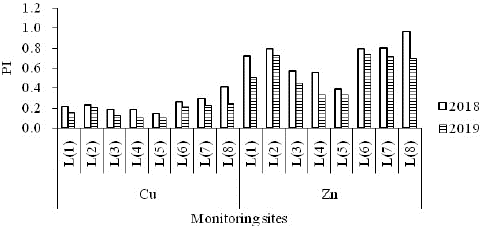
Figure 4: Pollution Index (PI) of the monitored croplands in the Lunbei area over the years. PI=1.0: non-pollution level, PI>1.0: slight pollution level, L: Lunbei.
Figures 5 and 6 show that the PN levels obtained from Shuilin and Huwei increased annually. The PN levels from the first monitoring point in Huwei and monitoring point 7 in Lunbei were the same (0.69), and in 2018, the condition was very close to the alert level (PN>0.7). However, the PN level of monitoring point 8 in Lunbei was calculated at 0.83 in the same year. Although this level decreased below the safe level (PN=0.7) in 2019, Cu and Zn may have continued accumulating.
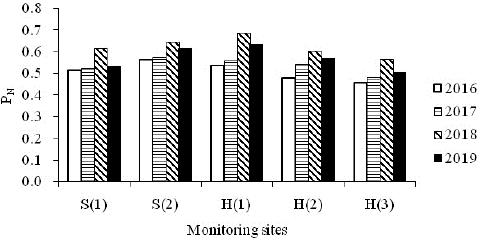
Figure 5: Nemerow pollution index of the monitored croplands in the irrigation groups in Shueilin and Huwei areas over the years. PN=0.7: safe level, PN>0.7: alert level, S: Shueilin, H: Huwei.

Figure 6: Nemerow pollution index of the monitored croplands in the irrigation groups in the Lunbei area over the years. PN=0.7: safe level, PN>0.7: alert level, L: Lunbei.
Metallic forms in the soil may give rise to different potential environmental threats. They are generally classified into five types: easily exchangeable, bound to carbonate, bound to iron and manganese oxyhydroxides, bound to organic matter, and residual. Exchangeable and bound carbonate forms are directly toxic to the environment, and metals bound to Fe and Mn oxyhydroxides are also potentially toxic. All forms of metals are available to plants except for the residual form. Therefore, the residual form alone did not have any environmental disadvantages. The speciation of Cu and Zn in the soil was determined to assess whether the soil was directly poisoned by Cu and Zn after irrigation with livestock wastewater.
As shown in Figures 7 and 8, the content of Cu bound to organic matter ranged from 30.0 to 71.5%, the content of residual Cu ranged from 20.0 to 60.7%, the content of Zn bound to Fe and Mn oxyhydroxides ranged from 15.9 to 49.6%, and residual Zn contents ranged from 26.6 to 70.9%. These results could be attributed to several factors. Cu preferentially combines with the organic matter due to its high affinity for adsorption sites on soil organic matter to form a stable complex [30,31,32]. Although Zn may complex with organic matter, weaker competitive sorption to Cu occurs before combining with iron and manganese oxides [33]. The analysis result was similar to the one proposed by [34], which showed that Cu mostly comprised residual and organic forms, whereas Zn comprised the residual form and the form bound to Fe and Mn oxyhydroxides (15.9–49.6%). Cu and Zn in livestock wastewater are considered potentially toxic to the environment because of their availability in crops. However, the amount of residual Cu was less than that of residual Zn, and Cu posed a greater potential environmental threat than Zn. In summary, Zn posed a higher threat if the total amount of heavy metals (index) was used for the assessment, but Cu posed a higher potential threat owing to its binding form. Although the Cu and Zn contents were restricted to a reasonable range in 2019, they could gradually accumulate in the future. Consequently, the soil at monitoring sites should be monitored.
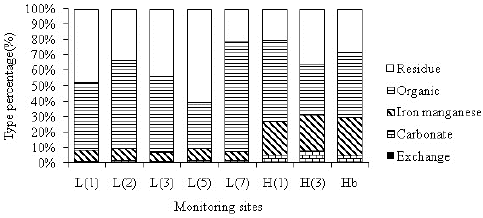
Figure 7: Fraction content of Cu species in soils at monitoring sites. L: Lunbei, H: Huwei, Hb: Huwei blank.
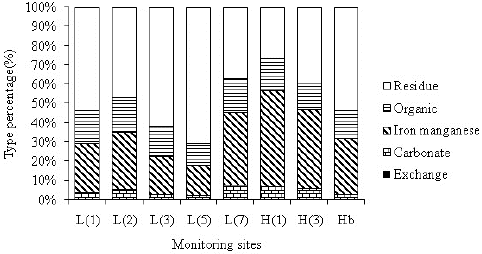
Figure 8: Fraction content of Zn species in soils at monitoring sites. L: Lunbei, H: Huwei, Hb: Huwei blank.
Using swine wastewater for irrigation poses a greater threat than liquid cow manure. This concept was because swine wastewater generally contains high levels of Cu and Zn. However, the index comparison results revealed that the accumulations of Cu and Zn in the Lunbei area were not lower than those in Shuilin and Huiwei. This was due to the high amount of irrigation using liquid cow manure. However, the average amount of irrigation in the Lunbei area was higher than those in the Shuilin and Huwei areas. In addition, massive amounts of biogas residue from cow manure remained on the soil surface, indicating that the effect of irrigation using liquid cow manure cannot be underestimated.
Conclusion
1. It can be inferred from the evaluation results of the Nemerow pollution index that all Cu and Zn contents ranged within a reasonable scope. Thus, the soils do not need to stop irrigation with livestock wastewater at the monitoring sites. However, these soils must be monitored for heavy metal accumulation.
2. Based on the amount of Zn in the soil, it is more harmful to health and approaches the alert level for stopping irrigation. In addition, Cu has a high potential toxicity in the form of heavy metals.
3. Sequential extraction investigations revealed that Cu bound to organic matter and Zn bound to amorphous Fe and Al oxyhydroxides were the major metals in the irrigated soils.
Regarding the environment, the threat from irrigation with liquid cow manure was not lower than that from irrigation with swine wastewater.
References
- Hu Y, Cheng H, Tao S. Environmental and human health challenges of industrial livestock and poultry farming in China and their mitigation. Environ Int. 2017; 107: 111-30.
- Villamar CA, Vera-Puerto I, Rivera D, De la Hoz F. Reuse and recycling of livestock and municipal wastewater in Chilean Agriculture: A preliminary assessment. Water. 2018; 10: 817.
- Yang X, Li Q, Tang Z, Zhang W, Yu G, Shen Q, et al. Heavy metal concentrations and arsenic speciation in animal manure composts in China. Waste Manag. 2017; 64: 333-9.
- Suzuki K, Waki M, Yasuda T, Fukumoto Y, Kuroda K, Sakai T, et al. Distribution of phosphorus, copper and zinc in activated sludge treatment process of swine wastewater. Bioresour Technol. 2010; 101: 9399-404.
- Hu H, Li X, Wu S, Yang C. Sustainable livestock wastewater treatment via phytoremediation: current status and future perspectives. Bioresour Technol. 2020; 315: 123809.
- Li MS, Luo YP, Su ZY. Heavy metal concentrations in soils and plant accumulation in a restored manganese mineland in Guangxi, South China. Environ Pollut. 2007; 147: 168-75.
- Zhou B, Wang C, Zhao Q, Wang Y, Huo M, Wang J, et al. Prevalence and dissemination of antibiotic resistance genes and coselection of heavy metals in Chinese dairy farms. J Hazard Mater. 2016; 320: 10-7.
- Fan MS, Zhao FJ, Fairweather-Tait SJ, Poulton PR, Dunham SJ, McGrath SP. Evidence of decreasing mineral density in wheat grain over the last 160 years. J Trace Elem Med Biol. 2008; 22: 315-24.
- Yari AA, Varvani J, Zare R. Assessment and zoning of environmental hazard of heavy metals using the Nemerow integrated pollution index in the vineyards of Malayer city. Acta Geophys. 2021; 69: 149-59.
- Dey M, Akter A, Islam S, Chandra Dey S, Choudhury TR, Fatema KJ, et al. Assessment of contamination level, pollution risk and source apportionment of heavy metals in the Halda River water, Bangladesh. Heliyon. 2021; 7: e08625.
- Das A, Joardar M, De A, Mridha D, Chowdhury NR, Bin Kashim Khan MT, et al. Pollution index and health risk assessment of arsenic through different groundwater sources and its load on soil-paddy-rice system in a part of Murshidabad district of West Bengal, India. Groundw Sustain Dev. 2021; 15: 100652.
- Wang JX, Luo L, Chen YC, He QM, Zhan LL. The characteristics and potential risk of heavy metals pollution in farmland soil of an agricultural land in the Three Gorges Reservoir area. J Agric Environ Sci. 2018; 37: 2711-7.
- Wang Z, Liu X, Qin H. Bioconcentration and translocation of heavy metals in the soil-plants system in Machangqing copper mine, Yunnan Province, China. J Geochem Explor. 2019; 200: 159-66.
- Nemerow NL. Stream, lake, estuary, and ocean pollution. 1st ed. New York: Van Nostrand Reinhold; 1985.
- Cheng B-Y, Fang W-T, Shyu G-S, Chang T-K. Distribution of heavy metals in the sediments of agricultural fields adjacent to urban areas in Central Taiwan. Paddy Water Environ. 2013; 11: 343-51.
- Yan N, Liu W, Xie H, Gao L, Han Y, Wang M, et al. Distribution and assessment of heavy metals in the surface sediment of Yellow River, China. J Environ Sci (China). 2016; 39: 45-51.
- Karimi Nezhad MT, Tabatabaii SM, Gholami A. Geochemical assessment of steel smelter-impacted urban soils, Ahvaz, Iran. J Geochem Explor. 2015; 152: 91-109.
- Zhang L, Yang XM, Drury CF, Chantigny M, Gregorich E, Miller J, et al. Infrared spectroscopy prediction of organic carbon and total nitrogen in soil and particulate organic matter from diverse Canadian agricultural regions. Can J Soil Sci. 2017; 98: 1.
- American Public Health Association, American Water Works Association, Water Pollution Control Federation. Method 4500-NH3. In: Standard methods for the examination of water and wastewater. 23rd ed. Washington, DC: American Water Works Association. 2017; 4-114~4-120.
- Tessier A, Campbell PGC, Bisson M. Sequential extraction procedure for the speciation of particulate trace metals. Anal Chem. 1979; 51: 844-51.
- Dawood AS. Using multivariate statistical methods for the assessment of the surface water quality for a river: A case study. Int J Civ Eng Technol. 2017; 8: 588-97.
- Fei X, Xiao R, Christakos G, Langousis A, Ren Z, Tian Y, et al. Comprehensive assessment and source apportionment of heavy metals in Shanghai agricultural soils with different fertility levels. Ecol Indic. 2019; 106: 105508.
- Zang F, Wang S, Nan Z, Ma J, Zhang Q, Chen Y, et al. Accumulation, spatio-temporal distribution, and risk assessment of heavy metals in the soil-corn system around a polymetallic mining area from the Loess Plateau, northwest China. Geoderma. 2017; 305: 188-96.
- Shil S, Singh UK. Health risk assessment and spatial variations of dissolved heavy metals and metalloids in a tropical river basin system. Ecol Indic. 2019; 106: 105455.
- Aransiola SA, Ijah UJJ, Abioye OP, Victor-Ekwebelem MO. Anammox in wastewater treatment. In: Maddela NR, García Cruzatty LC, Chakraborty S, editors. Advances in the domain of environmental biotechnology. Singapore: Springer. 2021; 393-415.
- Oh HJ, Park YJ, Cho JH, Song MH, Gu BH, Yun W, et al. Changes in diarrhea score, nutrient digestibility, zinc utilization, intestinal immune profiles, and fecal microbiome in weaned piglets by different forms of zinc. Animals (Basel). 2021; 11: 1356.
- Ding H, Zhang Q, Xu H, Yu X, Chen L, Wang Z, et al. Selection of copper and zinc dosages in pig diets based on the mutual benefit of animal growth and environmental protection. Ecotoxicol Environ Saf. 2021; 216: 112177.
- Lehmann RG, Harter RD. Copper adsorption by soils exposed to desiccation stress. Soil Sci Soc Am J. 1983; 47: 1085-8.
- Liu CC, Li YS, Chen YM, Wang MK, Chiou CS, Yang CY, et al. Biosorption of chromium, copper and zinc on rice wine processing waste sludge in fixed bed. Desalination. 2011; 267: 20-4.
- Lasheen MR, Ammar NS. Assessment of metals speciation in sewage sludge and stabilized sludge from different wastewater treatment plants, Greater Cairo, Egypt. J Hazard Mater. 2009; 164: 740-9.
- Illera V, Walter I, Souza P, Cala V. Short-term effects of biosolid and municipal solid waste applications on heavy metals distribution in a degraded soil under a semi-arid environment. Sci Total Environ. 2000; 255: 29-44.
- Tiecher TL, Ceretta CA, Comin JJ, Girotto E, Miotto A, Moraes MPd, et al. Forms and accumulation of copper and zinc in a sandy typic hapludalf soil after long-term application of pig slurry and deep litter. Rev Bras Ciênc Solo. 2013; 37: 812-24.
- Walter A, Auer M, Ritter T. The impact of network capabilities and entrepreneurial orientation on university spin-off performance. J BusVentur. 2006; 21: 541-67.
- Beygi M, Jalali M. Assessment of trace elements (Cd, Cu, Ni, Zn) fractionation and bioavailability in vineyard soils from the Hamedan, Iran. Geoderma. 2019; 337: 1009-20.